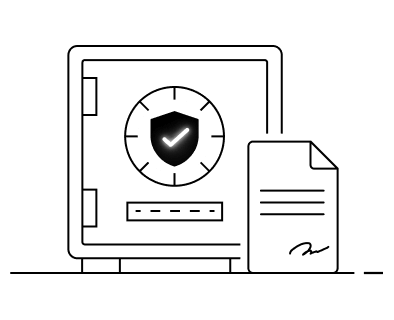








欧易对资产透明度的追求
作为一家数字货币交易所,欧易深知用户的资金安全是我们的首要责任。 欧易始终为用户资产保持 1:1 的储备金,拥有首屈一指的安全性和流动性,在业内有口皆碑。
欧易的链上钱包资产公开透明,用户可以随时验证他们的资金有 1:1 的真实资产支持。
我们致力于保持 1:1 的储备金率,并每月发布储备金证明报告,为数字货币行业设立了更高标准,展示了我们对于推动平台健康成长以及保障客户资金和净余额数据准确性的承诺。储备金证明是平台与监管机构建立信任的关键,对促进健康可持续的数字货币生态至关重要。


什么是储备金证明?
储备金证明通过加密的证明方法来确认数字货币交易所在特定时间在某区块链上持有特定金额的资产,提升账户总资产和交易所存款总额的透明度,同时不会泄露任何有关个人账户余额的敏感信息,使储备金证明成为数字货币生态的关键组成部分。
用作储备的资产是具有较强流动性、市场广泛接受的数字货币。欧易提供多达 22 个币种的储备金证明,包括 , 及 , 等稳定币。
储备金证明的原理是怎样的?
我们使用一种叫做“zk-STARK”的 零知识证明 算法,来证明并验证交易所持有的所有欧易账户资产。
我们会验证欧易链上钱包地址的所有权及欧易钱包资产总额。
最后,我们会通过对比欧易账户资产及已公布的欧易链上钱包地址中的交易所总资产,来验证欧易平台的资产储备金率。
什么是 zk-STARK?
欧易如何通过 zk-STARK 验证您的资产
欧易对每个用户的资产余额进行快照,然后将这些数据输入到一个记录表和加密的“默克尔树”系统中,创建一个可以有效防止篡改的审计记录,可用于验证余额数据的准确性。
设定三条账户资产余额必须满足的规则或“约束”,如果每项约束都通过验证,即可证明欧易资产储备的真实性。
规则 1:余额总和约束
欧易持有的账户资产总量等于每个账户资产余额的总和。
规则 2:非负约束
每个账户的总余额大于零,他们的资产在核算时也包含了负债,并确保每个账户的净资产为正。这对于维持数字货币交易所的偿付能力至关重要。
规则 3:包含性约束
每个账户的总余额都包含在计算和验证过程中。
如何验证欧易对钱包地址的所有权及钱包资产
如何验证欧易的储备金率
用户可以对比欧易的链上钱包地址资产和默克尔树根内的欧易账户总资产。
如果欧易链上资产大于或等于账户的总资产,则证明欧易拥有足够的资产储备。
注意:此报告是获取数据时欧易账户的资产快照,快照未涵盖的资产及快照结束后的任何交易将不会包含在此报告内。
如何自行验证储备金证明?
验证包含性约束
报告数据范围:2024年9月起
- 如需查看自己的账户资产是否包含在默克尔叶节点中,请进入“”页面并点击“详情”,即可查看您的报告数据。
点击“复制数据”获取验证所需的数据,并将 JSON 文本文件粘贴至一个新建文件夹。文件名必须以“_inclusion_proof.json” 结尾。
- 下载欧易的开源验证工具 并将其保存至上一步新建的文件夹。
打开 zk-STARK Validator 即可自动运行您保存的 JSON 文件。
若您通过验证,执行结果 “Inclusion constraint validation passed” 将显示如下:
如果验证失败,执行结果“Inclusion constraint validation failed”将显示如下:
查看 2023年3月16日默克尔树 v2 的
查看 2023年4月22日 ~ 2024年8月8日期间我们的 zk-STARK
验证余额总和约束和非负约束
您可以通过以下步骤验证欧易持有的资产是否真实,以及是否有账户持有负资产:
- 在“”页面下的“账户余额文件”部分下载 zk-STARK 文件。
将下载到的文件解压缩,您将得到一个名为 “sum_proof_data.json” 的文件夹。
- 下载欧易的开源验证工具 ,并将其与 “sum_proof_data.json” 保存在相同的根目录下。
打开 zk-STARK Validator 自动运行已解压缩的 zk-STARK 文件。
如果验证通过,执行结果 “Total sum and non-negative constraint validation passed” 将显示如下:

如果验证失败,执行结果“Total sum and non-negative constraint validation failed”将显示如下:
验证欧易对钱包地址的所有权及钱包资产
若您希望验证您的欧易钱包地址的所有权并查看余额,您可以将其与我们公布的钱包地址列表进行比较。
欧易会公开指定币种的持币地址(包括币种,余额及签名),并用对应的私钥签名一条消息 “I am an OKX address”。
以比特币 (BTC) 为例,您可以按照以下步骤验证自己的 BTC 钱包地址和余额:
- 前往“”下载公开的钱包地址信息。
- 从 下载欧易的开源验证工具开始验证过程。
打开下载到的钱包地址文件,复制下图中红色方框标示的信息,需分别复制 BTC 地址、签名和 message。
- 您可以通过余额验证工具 来验证欧易在快照生成时链上对应区块高度的钱包地址余额。